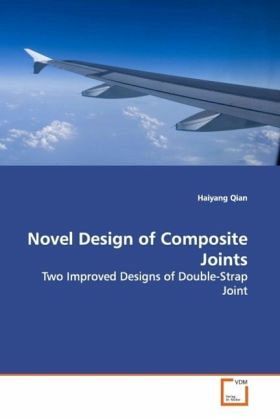
Novel Design of Composite Joints
Two Improved Designs of Double-Strap Joint
Versandkostenfrei!
Versandfertig in 6-10 Tagen
32,99 €
inkl. MwSt.

PAYBACK Punkte
16 °P sammeln!
Adhesively bonded joints have been applied widely inmany industries especially with composite materials. Because of the unavoidable geometric change,discontinuity or material change, the joints or thejoint areas are potentially the weakest regions instructures. Thus the design of the structural jointsis very critical for the whole structure and must bevery carefully designed. In this book, two newdesigns were introduced to improve the performance ofthe double-strap joint. For the first design, thinstep composite laminate attachments were designed andattached onto the conventional double-strap ...
Adhesively bonded joints have been applied widely in
many industries especially with composite materials.
Because of the unavoidable geometric change,
discontinuity or material change, the joints or the
joint areas are potentially the weakest regions in
structures. Thus the design of the structural joints
is very critical for the whole structure and must be
very carefully designed. In this book, two new
designs were introduced to improve the performance of
the double-strap joint. For the first design, thin
step composite laminate attachments were designed and
attached onto the conventional double-strap joints.
For the second one, multiple layers of straight
attachments were used instead of one single layer. In
both new designs, additional load transfer paths were
created and localized interfacial stress
concentrations at the leading joint edge of the joint
were reduced. Experiments were performed and the
results revealed that both of the new designs had
significantly greater strengths than the conventional
double-strap joint. Interfacial stresses along the
bondlines were analyzed in order to understand the
increase in joint strength and the change of failure
modes in the joints.
many industries especially with composite materials.
Because of the unavoidable geometric change,
discontinuity or material change, the joints or the
joint areas are potentially the weakest regions in
structures. Thus the design of the structural joints
is very critical for the whole structure and must be
very carefully designed. In this book, two new
designs were introduced to improve the performance of
the double-strap joint. For the first design, thin
step composite laminate attachments were designed and
attached onto the conventional double-strap joints.
For the second one, multiple layers of straight
attachments were used instead of one single layer. In
both new designs, additional load transfer paths were
created and localized interfacial stress
concentrations at the leading joint edge of the joint
were reduced. Experiments were performed and the
results revealed that both of the new designs had
significantly greater strengths than the conventional
double-strap joint. Interfacial stresses along the
bondlines were analyzed in order to understand the
increase in joint strength and the change of failure
modes in the joints.












